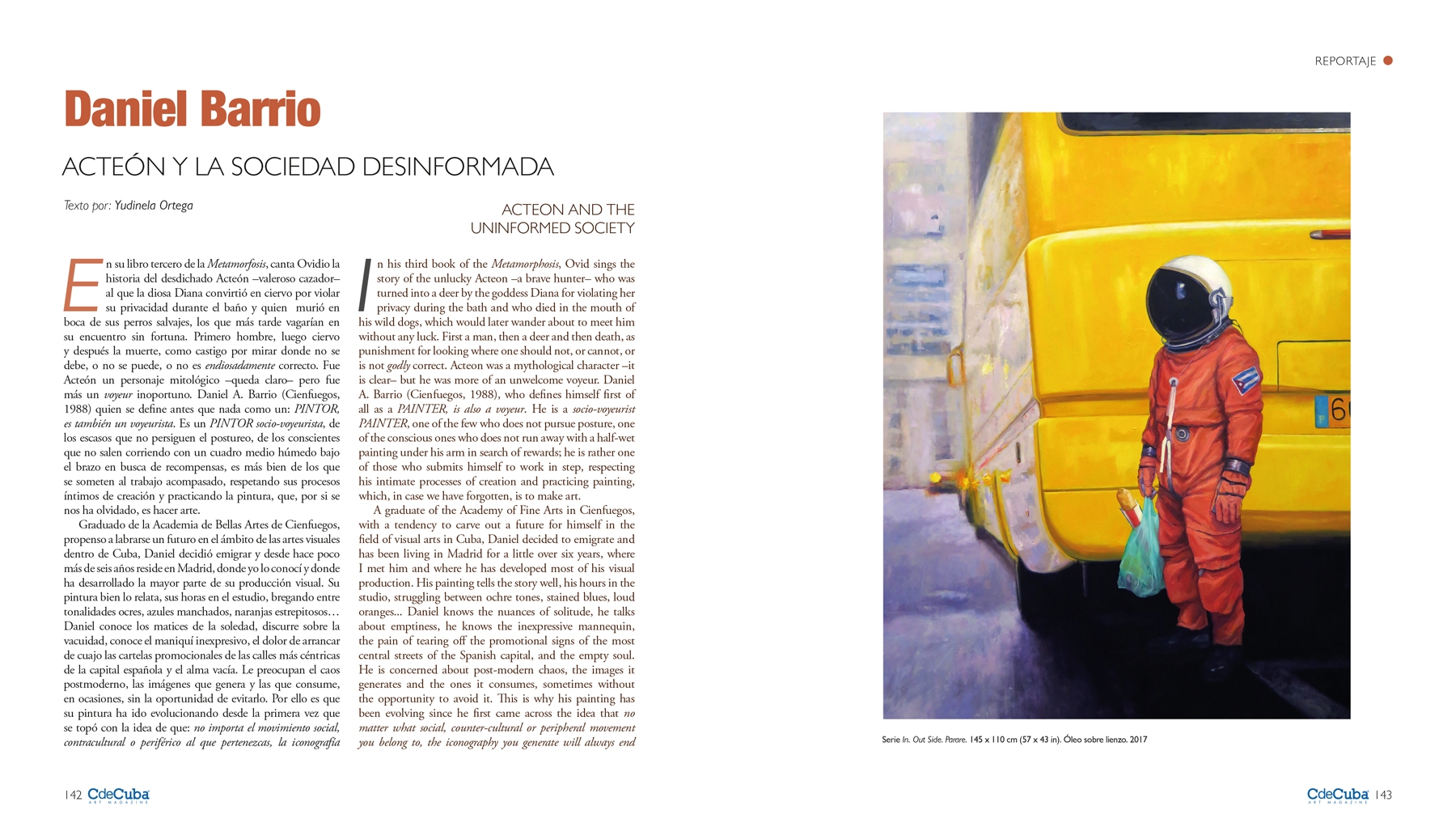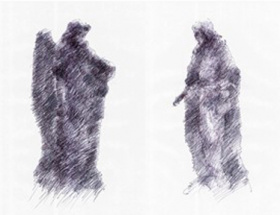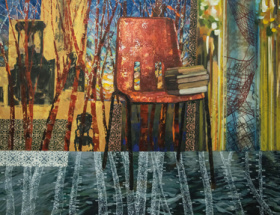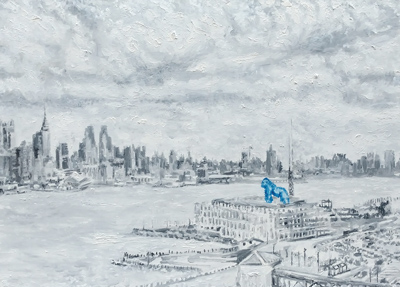Acteon and the Uninformed Society
By Yudinela Ortega
Fill them with fireproof news. They’ll feel the information drowning them out,
but they’ll think they’re smart. They’ll think they’re thinking,
they’ll have a
sensation of movement without moving. And they’ll be happy.
(Ray Bradbury, Fahrenheit 451, 1953)
In his third book of the Metamorphosis, Ovid sings the story of the unlucky Acteon –a brave hunter– who was turned into a deer by the goddess Diana for violating her privacy during the bath and who died in the mouth of his wild dogs, which would later wander about to meet him without any luck. First a man, then a deer and then death, as punishment for looking where one should not, or cannot, or is not godly correct. Acteon was a mythological character –it is clear– but he was more of an unwelcome voyeur. Daniel A. Barrio (Cienfuegos, 1988), who defines himself first of all as a PAINTER, is also a voyeur. He is a socio-voyeurist PAINTER, one of the few who does not pursue posture, one of the conscious ones who does not run away with a half-wet painting under his arm in search of rewards; he is rather one of those who submits himself to work in step, respecting his intimate processes of creation and practicing painting, which, in case we have forgotten, is to make art.
A graduate of the Academy of Fine Arts in Cienfuegos, with a tendency to carve out a future for himself in the field of visual arts in Cuba, Daniel decided to emigrate and has been living in Madrid for a little over six years, where I met him and where he has developed most of his visual production. His painting tells the story well, his hours in the studio, struggling between ochre tones, stained blues, loud oranges… Daniel knows the nuances of solitude, he talks about emptiness, he knows the inexpressive mannequin, the pain of tearing off the promotional signs of the most central streets of the Spanish capital, and the empty soul. He is concerned about post-modern chaos, the images it generates and the ones it consumes, sometimes without the opportunity to avoid it. This is why his painting has been evolving since he first came across the idea that no matter what social, counter-cultural or peripheral movement you belong to, the iconography you generate will always end up in the hands of big industries and in the clutches of a market turned into a souvenir. (1) I share your ideas about the manipulation of creativity and the stripping away of meaning that images have, once they are put into dialogue in other contexts and their essence is overshadowed by the verbalization of a current that makes us homogenous and minimizes us as individuals. This is what has motivated me to write about this Cuban artist, a son of mixed races, of hybridization, of the approach to the image, of the return to the craft focused on the proliferation of new language structures, visuality, recycling of meanings and communication in the pos-t-modern era.
During the years of work in which D.A.B. has focused on bringing together a whole amalgam of information –that perennial residue we are leaving behind– he has done so from an exasperating symbolism in which individuals have been represented as managers of a social barricade, a silent force on the fringes of the status quo that pretends to perpetuate itself in the suburbs without opposition to the power that excludes them. However, when we approach his series City, 2016 -the first contact with the artist’s social voyeurism– the irascible attitude of the men and women who inhabit the foreground of his paintings is palpable. Undefined, dull or camouflaged faces, bodies hidden under an umbrella shell, the inactivity of a pose or simply crowded into a subway car. Discomfort is defined here, not fitting into a collective immobilized behind the apparent veil of connectivity. Silence is a common denominator in this series. This is where the story of the power that is so important to D.A.B. opens up. The same power that takes the temperature of the state of things with which we live and opens up the vortex of attention to that palimpsest of metadata that amalgamates us, a rotten thing that today is self-generated in our cerebral cortex and that promises the loss of individuality: free homogeneity for all.
In. Out Side, 2017, is the second series of paintings produced by D.A.B; as in City, 2016, he appropriates the material offered to him by the mass media, locates the compositions that he can re-use in his pictorial discourse and maintains a constant representation of agglomerated bodies with hypocritical comfort, thus subscribing to this sort of scenario as an invariable principle in his visual narrative. It is at this point of his production where we can appreciate that hybridization and those referential winks he has inherited and it is sobecause in Cuba the figure of the cosmonaut has remained in the imagery of children and young people, one of the many legacies of the Soviet presence on the island. From Yuri Gagarin to Arnaldo Tamayo Méndez, each one of us has dreamed at one point of traveling to the cosmos. Thus D.A.B. incorporates in his representations a new character: The Cosmonaut, an alter ego, a mythological presence that will assume the role of voyeur inside the frame; his journey will not be to the Moon, but to the interior of any daily event. He will be, in this case, the postmodern Acteon that escapes from the pretentious, scrutinizes the story that hides in the grimaces or in the abducted attention to contents that have nothing to do with us. In. Out Side marks a turning point in his young career. In this series the artist transforms the idea of marginality with which he began to work. He includes an anachronistic character in regular scenes as a metaphor for an extended discontent, of tacit disagreement with society. Sometimes his presence will be an add-on in common places, where the rest of those present do not hide but challenge the spectator with their gaze. For instants he will inhabit indefinite situations, as in Totem, 2017, where he has been extrapolated from any identifiable stage design and on a plastic chair he prepares to throw –like a javelin– the stone that he drags along, his existential yoke, a weight that he has carried since he was inoculated with the attraction of consumerism and places him in an advantageous position to put an end to his domination. The Cosmonaut revives that something that Foucault identified in the social body, classes, groups, in the individuals themselves, that escapes in a certain way to the power relations, something that is not the first matter more or less docile or reluctant, but the centrifugal movement, the inverse energy, the escape. (2)
In the Tribud Series, 2018, the breakaway has become a showdown. From inertia it has moved to prudent action, meticulously planned to overthrow or at least sabotage the impact of souvenir culture. At this time, gestures are taking on their highest level of expression. Scenes built in a passive city environment have already been disqualified; mobile devices that kept the characters absorbed in that other reality have been discarded. D.A.B. has transformed his paintings into battlefields, where residual mannequins, totemic presences and animal allegories converge. A pastiche of the absurd, interwoven with our past history, is put on the table in a unilateral dialogue with the uninformed and a-cultured society. Without a doubt, the fragmented lesson of the screens that transmit a sweetened and empty sense of life is recycled to transgress, from the purely pictorial, our notions of the present time.
Today, D.A.B. is an artist with a more emphatic and defined poetics. He has displaced his representational codes towards a less expressive but more imposing type of painting. He continues to respect the production processes he undertakes, not only within a blank canvas. He has found a new type of formal solution that he executes from the recycling of advertising posters that he finds in his diary, which he discards, submitting the paper to a shredding process –that could be read as the antithesis of the accelerated production rhythm at present– from which an amalgam of waste results that he takes as a support for his works. They belong to this series: Movement Study and Movement Study II, both from 2019. They represent two figures carrying out activities that have nothing to do with each other: an anodyne golf game and an eternal embrace as culmination of the confinement and devastation suffered by the alienated flesh in its grave.
In the era of the image, in the civilization of the two hundred and eighty characters, there is a Cuban artist who lives in Madrid, on the fringes of power relations, but emanating meaning with the impact of his lacerating painting, his abuse of the absurd, his strange psychopathic social voyeurism. I am not going to ask for permission to poeticize about him, to rethink what is valid in these times that run in nebula, where those who do not coexist with the system are silenced and those who have nothing to say are praised. Understand me, I will only ask for permission when Acteon is reborn in his myth and poses his defiant gaze where it belongs.
1. Excerpt from the artist’s statement. http://daniel-barrio.com/statement/
2. Michel Foucault. “Powers and Strategies”, p.77. Initially published in Les Revoltes Logiques, no.4, 1977.






